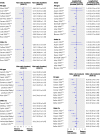Interventions to improve water quality for preventing diarrhoea: systematic review and meta-analysis
- PMID: 17353208
- PMCID: PMC1851994
- DOI: 10.1136/bmj.39118.489931.BE
Interventions to improve water quality for preventing diarrhoea: systematic review and meta-analysis
Abstract
Objective: To assess the effectiveness of interventions to improve the microbial quality of drinking water for preventing diarrhoea.
Design: Systematic review.
Data sources: Cochrane Infectious Diseases Group's trials register, CENTRAL, Medline, Embase, LILACS; hand searching; and correspondence with experts and relevant organisations.
Study selection: Randomised and quasirandomised controlled trials of interventions to improve the microbial quality of drinking water for preventing diarrhoea in adults and in children in settings with endemic disease.
Data extraction: Allocation concealment, blinding, losses to follow-up, type of intervention, outcome measures, and measures of effect. Pooled effect estimates were calculated within the appropriate subgroups.
Data synthesis: 33 reports from 21 countries documenting 42 comparisons were included. Variations in design, setting, and type and point of intervention, and variations in defining, assessing, calculating, and reporting outcomes limited the comparability of study results and pooling of results by meta-analysis. In general, interventions to improve the microbial quality of drinking water are effective in preventing diarrhoea. Effectiveness was not conditioned on the presence of improved water supplies or sanitation in the study setting and was not enhanced by combining the intervention with instructions on basic hygiene, a water storage vessel, or improved sanitation or water supplies--other common environmental interventions intended to prevent diarrhoea.
Conclusion: Interventions to improve water quality are generally effective for preventing diarrhoea in all ages and in under 5s. Significant heterogeneity among the trials suggests that the level of effectiveness may depend on a variety of conditions that research to date cannot fully explain.
Conflict of interest statement
Figures


Comment in
-
Quality of drinking water.BMJ. 2007 Apr 14;334(7597):755-6. doi: 10.1136/bmj.39168.485544.BE. BMJ. 2007. PMID: 17431230 Free PMC article.
References
-
- World Health Organization. The world health report: 2005: make every mother and child count Geneva: WHO, 2005 - PubMed
-
- World Health Organization. Progress towards the Millennium development goals, 1990-2005 (http://unstats/un.org/unsd/mi/goals_2005/goal_4.pdf
-
- World Health Organization and United Nations Children's Fund. Global water supply and sanitation assessment Geneva: WHO/UNICEF, 2000
-
- Cairncross S. Water supply and sanitation: an agenda for research. J Trop Med Hyg 1989;92:301-14. - PubMed
-
- Esrey SA, Habicht J-P. Epidemiologic evidence for health benefits from improved water and sanitation in developing countries. Epidemiol Rev 1986;8:117-28. - PubMed
Publication types
MeSH terms
LinkOut - more resources
Full Text Sources
Medical
